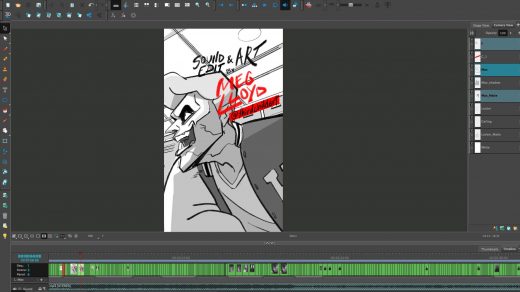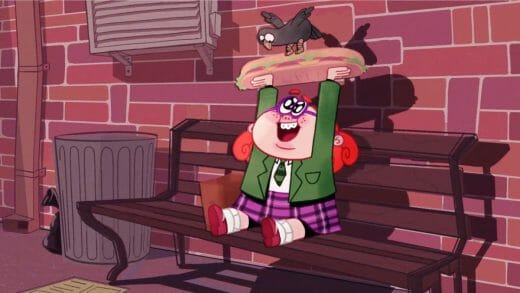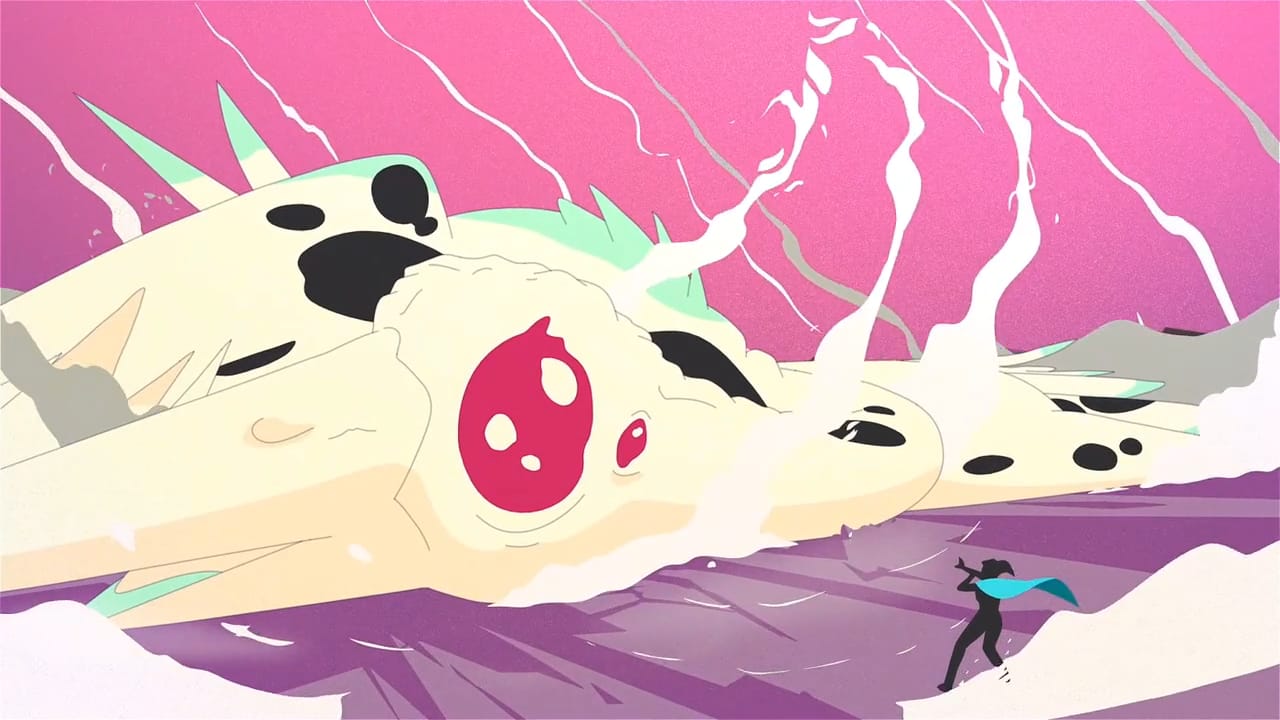
Atómica est un vidéoclip animé de KIOSKO, créé pour le groupe équatorien Cementerio de Elefantes. Le court métrage suit Atómica qui cherche à trouver la source de la dégradation qui affecte sa maison, un arbre magnifique et verdoyant. Elle traverse des paysages d’un autre monde à la recherche des anthropomorphes destructeurs qui sèment la pagaille dans sa patrie naturelle. Les créateurs du film sont un trio d’animateurs et d’illustrateurs talentueux : Facundo Quiroga, Sebastián García et Juan Nadalino. Commencé en 2019, Atómica met en valeur l’animation 2D pointue et le style artistique unique du studio.
Facundo et Juan ont été les fers de lance de la préproduction du projet, avec l’écriture du scénario, le storyboard et l’animatique, tandis que les trois membres ont contribué à la réalisation et à l’animation. Atómica marque leur première collaboration en tant que studio, et c’est en équipe qu’ils ont géré tous les aspects de la production, de l’écriture du scénario à l’animation, en utilisant Toon Boom Harmony pour ses outils d’animation image par image, ses nettoyages de lignes vectorielles et ses diverses capacités de coloration. L’animation mélange des images vibrantes et austères pour représenter les différentes phases de l’histoire. Atómica a été bien accueilli dans les festivals internationaux et a remporté plusieurs prix.
Toon Boom Animation s’est entretenu avec les trois créateurs du projet, qui ont partagé leurs impressions sur le processus. Facundo, Sebastián et Juan partagent des conseils sur l’animation d’un projet musical ainsi que des conseils pour les artistes souhaitant présenter leur travail dans le cadre d’un festival. Pour découvrir de plus près cette œuvre animée psychédélique et atmosphérique, regardez Atómica et lisez l’intégralité de l’entrevue ci-dessous…
Veuillez présenter les trois membres de l’équipe et leur rôle dans le projet…
Juan : Le studio KIOSKO est composé de trois membres : Facundo Quiroga, Sebastián García et moi-même, Juan Nadalino. Nous sommes trois animateurs et illustrateurs spécialisés dans l’animation 2D image par image et Atómica a marqué le début de notre collaboration en tant que studio.
Atómica a commencé comme un projet créé par Facundo et moi-même, qui nous sommes occupés de la préproduction, du scénario, du storyboard et de l’animatique. Facundo s’est ensuite chargé de toutes les illustrations du clip, tandis que la direction et l’animation ont été entièrement réalisées par nous trois.
Comment ce projet a-t-il vu le jour?
Juan : En 2019, nous travaillions encore en tant qu’indépendants dans le domaine de la publicité et nous avons eu envie de créer une animation non commerciale pour présenter nos propres idées. Par coïncidence, un ami membre du groupe équatorien Cementerio de Elefantes était à la recherche d’un vidéoclip animé pour l’une de leurs chansons.
C’est ainsi qu’est né Atómica, un projet collaboratif dans le cadre duquel nous avons eu toute latitude pour créer une histoire animée à partir de zéro, avec notre propre art et sans les limites des projets publicitaires.
Quel a été l’accueil critique réservé à Atómica?
Facundo : Dès que nous avons terminé le vidéoclip, il a commencé son voyage à travers les festivals du monde entier avec l’aide de la société de distribution Animation 1908. Nous sommes très fiers de dire qu’il a été sélectionné pour plusieurs festivals internationaux, et que nous avons même remporté le prix du meilleur vidéoclip musical dans certains d’entre eux! Il a également été présenté récemment sur Behance, où il a reçu de nombreux commentaires positifs.
Comment décririez-vous le style artistique frappant utilisé dans le vidéoclip?
Juan : Bien qu’il soit clair que nous voulions utiliser Atómica comme un prétexte pour mettre en valeur nos compétences en tant qu’animateurs et illustrateurs, le style artistique a également évolué en fonction des besoins de la production.
Facundo : Au départ, nous pensions que dessiner le personnage principal avec une ligne uniforme et des couleurs solides simplifierait le processus de nettoyage. Cependant, cette première décision a donné à l’art un aspect plat et nous ne voulions pas nous engager dans cette voie. Nous avons donc commencé à ajouter des couches d’atmosphère et de profondeur aux différentes scènes. Nous voulions que chaque plan soit visuellement frappant.
Même temps, la seconde moitié du vidéoclip présente un trait plus grossier, proche de l’esquisse, et une palette plus réduite. C’est à ce moment-là que nous avons réalisé que le contraste entre le début coloré et vivant et la blancheur austère de la mort avec l’apparition des “anthropomorphes” fonctionnait également d’un point de vue conceptuel.
Sebastián : Pour toutes ces raisons, nous disons que le style artistique a été construit à partir des besoins de la production tout en essayant de s’assurer que la narration et les éléments visuels se complètent. Quoi qu’il en soit, ce projet nous a appris quelque chose : quel que soit le style artistique, l’animation image par image nécessite toujours un temps de travail correspondant.
Quels sont les outils d’Harmony qui vous ont aidé à créer des animations dans ce style?
Sebastián : L’ensemble du vidéoclip a été animé avec Harmony, principalement à l’aide d’outils d’animation image par image. Nous avons fait des croquis avec des pinceaux, puis nous les avons nettoyés avec des lignes vectorielles. Les outils de coloration ont également joué un rôle fondamental dans notre processus. Nous avons tiré pleinement parti de la large gamme d’outils que Toon Boom offre pour l’animation traditionnelle, ce qui nous a permis de créer des scènes très diverses et complexes.
Juan : Dans de nombreuses scènes, les mouvements de caméra ont été effectués directement dans Harmony. Dans la scène de la chute de la grue, qui est l’une des plus complexes, nous avons utilisé toutes les ressources disponibles. Cette scène est entièrement animée et composée dans Toon Boom Harmony, y compris les effets visuels tels que les flous et les mouvements de caméra.
Y a-t-il des influences notables sur le style visuel d’Atómica?
Facundo : En tant qu’animateurs ayant grandi dans les années 90, nous nous sommes permis d’exprimer nos influences de l’animation japonaise dans l’Atómica, un style qui était très en vogue en Argentine à cette époque. Nous nous sommes également inspirés des sculptures de Max Leiva et des éléments de la nature. Par exemple, pour créer le monde d’Atómica, nous avons fait des recherches approfondies sur le monde des champignons, car c’est un élément qui devait être présent dès le début. La phrase de la chanson “I Will Find The Magic Within The Chaos” (Je trouverai la magie dans le chaos) a été un point de départ crucial dans le choix du style.
Comment avez-vous choisi la palette de couleurs pour Atómica?
Facundo : En ce qui concerne les couleurs, nous voulions marquer clairement deux moments dans l’histoire. Un moment plein de vie avec des couleurs variées et vibrantes, typiques de la nature dans sa plénitude ; et d’autre part, la couleur osseuse qui représente la destruction, la décomposition et la mort que les antagonistes de cette animation apportent avec eux.
Juan : Nous pensons beaucoup à l’idée qu’une explosion atomique efface tout et ne laisse que du blanc et de la poussière. Pour renforcer ce contraste, la couleur du début devait être absolument vive.
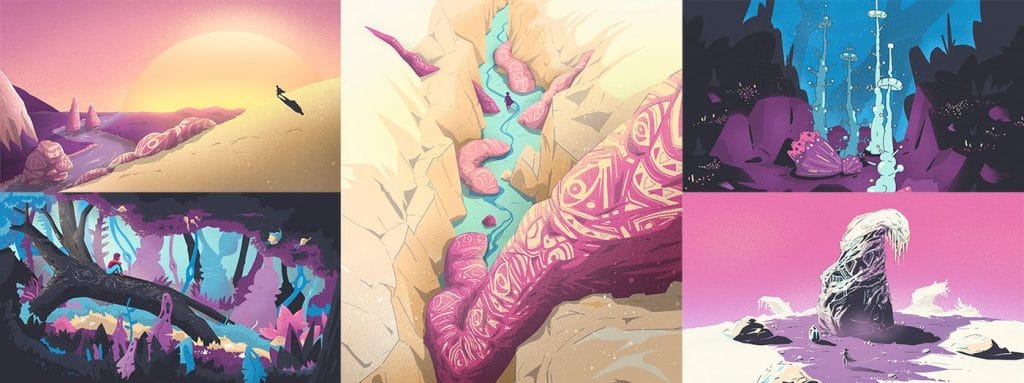
Quel a été le plus grand défi que vous avez relevé dans le cadre de la production?
Sebastián : Comme il s’agissait d’un projet de grande envergure réalisé par quelques personnes seulement, le plus grand défi a été de maintenir la motivation au fil du temps. Malgré un financement limité et une pandémie qui nous a considérablement ralentis, nous avons continué et terminé le projet.
Juan : Ce processus nous a également permis d’apprendre beaucoup de choses et, en cours de route, nous nous sommes consolidés en tant qu’équipe et avons créé Kiosko.
Quel conseil donneriez-vous aux animateurs qui souhaitent travailler sur des vidéoclips?
Juan : Tout d’abord, il faut inclure un producteur dans l’équipe! Lors du processus Atómica, nous avons commencé sans grande expérience et nous n’avions pas imaginé que le rôle de producteur pouvait être si important pour maintenir les idées dans un cadre réalisable. En l’absence d’une personne capable de planifier la réalisation du projet, l’idée est devenue si complexe qu’il nous a fallu des années pour l’achever.
Sebastián : Au cours de cette période, nous avons appris que, surtout dans le domaine des vidéoclips, il est possible de réaliser des animations très efficaces, de grande qualité, en peu de temps et de s’adapter à différents budgets, à condition de planifier et d’optimiser les ressources de manière judicieuse. Souvent, une idée simple bien exécutée est beaucoup plus efficace qu’une idée complexe.
Ne sous-estimez pas le rôle de la production et profitez de l’éventail de ressources narratives qu’offre le format du vidéoclip pour gagner du temps.
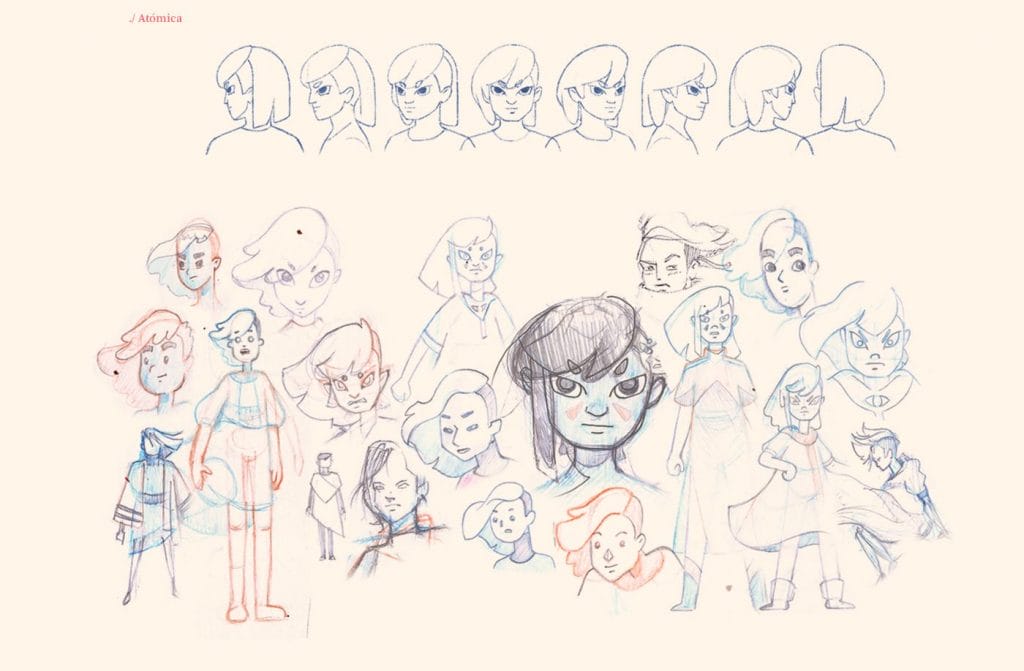
En quoi le processus de création d’un vidéoclip diffère-t-il de l’animation dans d’autres domaines?
Facundo : L’existence d’une piste musicale préalable est ce qui guide l’ensemble de la pièce animée, tant par son rythme et ses paroles que par son esthétique musicale propre.
Juan : D’autre part, comme nous l’avons déjà mentionné, le format du vidéoclip offre une grande liberté d’utilisation de toutes sortes de ressources narratives. Ce qui se passe dans la vidéo ne doit pas nécessairement respecter la structure temporelle d’une histoire classique. Visuellement, nous pouvons tout faire tant que cela s’inscrit dans l’univers que nous proposons. C’est un format très souple, plein d’expression et très suggestif.
Sebastián : Le vidéoclip est un excellent terrain d’exploration de l’esthétique et des idées.
Quelles sont les prochaines étapes pour vous et l’équipe de KIOSKO?
Sebastián : Nous travaillons actuellement sur un micro-court métrage pour le Nouns Fest, pour lequel nous avons été sélectionnés. Nous sommes également en train de développer une série en coproduction avec le podcast Radio Ambulante, qui raconte des histoires d’Amérique latine sur le réseau NPR aux États-Unis.
Facundo : Nous voulons travailler de plus en plus sur nos propres projets où nous pouvons exprimer notre propre point de vue et nous sommes enthousiastes à l’idée de passer de l’animation pour la publicité à la création de contenu original.
- Intéressé.e à en voir plus? Regardez Atómica par Cementerio de Elefantes ou supportez le groupe sur Bandcamp.
- Vous pensez à votre prochain projet indépendant? Les artistes peuvent télécharger une version d’essai gratuite de 21 jours de Toon Boom Harmony.


